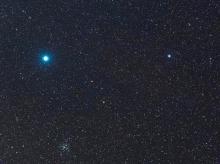Listen to today's episode of StarDate on the web the same day it airs in high-quality streaming audio without any extra ads or announcements. Choose a $8 one-month pass, or listen every day for a year for just $30.
You are here
Brightest Stars
The brightest star in the night sky scoots low across the south on winter nights. So do several past and future brightest stars. They’re all in Canis Major, the big dog.
The current champion is Sirius, the Dog Star, which is low in the southeast as night falls.
Sirius appears so bright for a couple of reasons. For one, it really is bright — about 25 times brighter than the Sun. For another, it’s close — less than nine light-years away.
Sirius and the Sun are moving through the galaxy at different rates, though, so they haven’t always been this close — and they won’t stay this close for long. The distances to other stars are changing as well, which means that other bright stars drift in and out of view — giving us different “brightest” stars at different times.
About 4.7 million years ago, the title belonged to Adhara, which today is the second-brightest star in the big dog. It’s much bigger and brighter than Sirius. So while it never got closer than about 34 light-years, it peaked at about 10 times Sirius’s current brightness. That’s as bright as Venus, which currently reigns as the “morning star.”
A few hundred thousand years later, another of the stars of Canis Major took the title. And about three million years from now, the brightest star will be NR Canis Majoris. It won’t be as bright as Sirius is today, but it’ll outshine all the other stars — one more bright light from the big dog.
Script by Damond Benningfield





